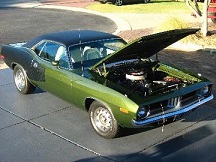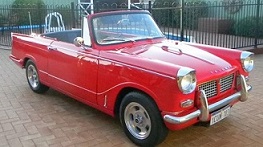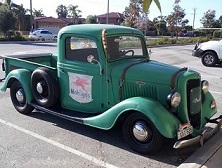|
Group: Forum Members
Last Active: 6 Years Ago
Posts: 174,
Visits: 1.7K
|
I am planning on changing to a double stage cylinder on my 63 f100. Is there anything I need to know before doing it. Is there anything in perticular for the new master cylinder. I know I have to get either a 66 or 67 to get the double stage. Does it need to say for use with front and rear drum brakes? Any other info or advice would be helpfull as I will be making my own lines(flaring them). About how much line will I need? Has anyone used stainless before? Is it hard to flare and is it really nessecary verses steel?
|
|
Group: Forum Members
Last Active: 4 Years Ago
Posts: 898,
Visits: 23.2K
|
If you still have the drums all round I would expect that you should try find one for drums as it will have some sort of residual built in, make sure your bore size is the same. just a note; some people change to a dual for "safety reasons" just be aware that on some with pedal ratios being different etc that even if you fail one circuit you may find your pedal on the floor anyway, giving you zip... If you plan to do your own lines make sure you have a good flaring tool like an Eastwood, don't try use a hand held crappy one your wasting your time. Stainless...? well I wouldn't bother unless your car is a real show piece, normal bundy tube is great you can bend it with your fingers, don't get anything too soft as I know with my Eastwood it doesn't like it. Replace all your hard lines, soft lines and hone your wheel cylinders too.. You will probably need more than the 25 foot rolls you get. Find a hose - fitting place near you and buy it off them, hunt around its not expensive.
   
"Came too close to dying to stop living now!"
|
|
Group: Forum Members
Last Active: 2 Years Ago
Posts: 476,
Visits: 22.0K
|
You may find you'll need to lengthen the push rod that goes from the pedal into the new master to get the correct pedal free play.
|
|
Group: Forum Members
Last Active: Last Year
Posts: 729,
Visits: 112.0K
|
Using NiCopp is the easiest to bend vs stainless. places like Summit have it and some on Ebay is cheaper. Don't forget that brake lines need a double flare so you need a double flare tool.
|
|
Group: Forum Members
Last Active: 6 Years Ago
Posts: 174,
Visits: 1.7K
|
Ok thanks for the advice. how would I know what the ratio is that you are talking about?
|
|
Group: Moderators
Last Active: Yesterday
Posts: 6.1K,
Visits: 443.0K
|
If you plan to keep it non power assisted, get a smaller bore master cylinder, 1" or smaller. Get drum / drum if it will remain drum / drum. The pedal ratio is the distance from the center of the pivot to about the center of the pad your foot rests on divide by the distance from the center of the pivot to the center of the pushrod bolt. I don't know where to find the recommended ratio for the dual master cylinder. You can make small changes to that ratio fairly easily but big changes will require pretty significant modifications. My advice if you install a dual master cylinder, drive it like it still has the single. You may not need a longer pushrod. The bolt which goes through the pedal is eccentric and has built in adjustability. The general design of the pushrod is also pretty common. A day at a junk yard should get several different lengths which can be modified to fit perfectly, if needed. I also agree, invest in a quality flare tool - you're going to spend a couple hundred dollars on this. The cheap ones are garbage and nothing but a headache.
Lawrenceville, GA
|
|
Group: Forum Members
Last Active: 6 Years Ago
Posts: 24,
Visits: 11.6K
|
I went through a complete brake rebuild on my 56 Victoria last summer, and I am presently changing over to a dual master cylinder now. I decided to go with the dual master cylinder after noticing that my Bendix and Raybestos wheel cylinders and original master cylinder were made in China. I just don't trust the elastomers and etc. so if I loose a wheel cylinder on the front I'll still have back brakes (and vice versa) using the dual master cylinder. I replaced all my metal lines with stainless steel ones from "Classic Lines" (I believe was the name). They were about $130, so that's less than you would pay for a quality double flare tool. Also, this will save you hours in trying to get the bends and lengths correct. The lines fit very will, but not perfect in a couple of locations. Since the lines are 3/16" on the 56 cars, I didn't have much trouble bending them. An exception was where there were larger lines over the 3/16" lines for protection (as per the factory). All other things being the same except regular steel verses stainless steel, the later will not be any more difficult to bend since both have nearly the same modulus of elasticity (which relates to material stiffness). My main reason for going to SS lines was due to the fact that brake fluid (except DOT5) absorbs water and therefore steel lines rust from both the outside in, and from the inside out. This is also a very good reason for renewing the brake lines on an old car - when they are almost rusted through, you can't tell by looking. The DOT5 fluid does not absorb water, but has other problems - such as potential elastomer incompatibility. Now for the dual master cylinder. I purchased one for a 1967 Mustang. After purchasing it, I got busy on other projects for several months and never opened the box. After looking at it, I noticed the push rod was installed and it wouldn't come out. Some research revealed that the push rod is supposed to be uninstalled, and it has a clip which expands into a groove when installed and essentually cannot be removed after that. Lesson learned - check the box to see that it is uninstalled. Some measuring revealed that the distance from the back of the flange to the center of the hole (into which the eccentric on the pedal goes) was shorter than original. I won't go into much detail on how I fixed this, except that I have a lathe and the push rod now includes an adjustable threaded (high strength) collar. Also, the eccentric only provides about 1/4" adjustment at the pedal. An important point is to make sure that there is some free play of the pedal at the upper end so that the piston in the master cylinder comes all the way back. If this doesn't happen, the brakes will start not releasing all the way as pressure in the lines will not be relieved. The importance of pedal ratio was previously mentioned. The question is - will the pedal activate all of the master cylinder stroke. In my case, I noticed that the stroke in the 67 Mustang MC was just a little shorter than the original. So, after bleeding the brakes, I broke a bleeder on the front and the pedal dead ended about 2" up off the floor. Same when breaking a bleeder on the rear. I haven't done at actual "rolling" test yet, but I will.
|
|
Group: Forum Members
Last Active: 6 Years Ago
Posts: 174,
Visits: 1.7K
|
I finally got the dual master cylinder installed.. I used a MC from a 67 f100 it bolted up easy and the lines were pretty easy I just used new lines. A little heat and pb blaster and all the fittings broke loose. The only question I have is on the MC you have the front and back connections the back connection has the bigger reservoir does the bigger reservoir need to go to the front or the back? Does it really matter? I assumed it went to the back as it has to travel further. It is all bleed out and the brake feels good and solid. Can anyone help me with this?
|
|
Group: Forum Members
Last Active: Last Year
Posts: 729,
Visits: 112.0K
|
Normally a master with a large and small reservoir are for disc/drum systems and the large one is for the front discs. Drum/drum masters have equal size reservoirs. I don't think a front disc reservoir master will have a residual valve like needed for front drums..
|
|
Group: Forum Members
Last Active: 6 Years Ago
Posts: 174,
Visits: 1.7K
|
well it said on application that it was for front drum brakes. plus they were not using disc brakes in 67 on the f100 were they?
|